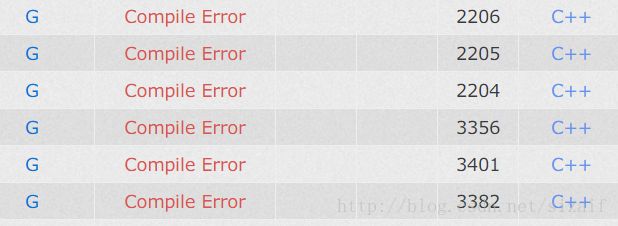To Be honset 夫走大学的 判题机是真心的烂,对STL库支持是如此的差,仍然在c++5.1--- bits/stdc++.h 头文件不支持
对于打多了CF的我来说 相当不友好, STL库 vector 动不动就超时超内存,pair也不敢用, 这能对着queue瑟瑟发抖.
习惯了直接cin, 不习惯EOF 了.

A - 奖励
FZU - 2258
福州大学某班共有n名学生,这些学生这学期都选修了3门课,分别是大物、高数、大英。YellowStar想对这学期总绩点不低于3.0的学生进行奖励,所以他将每名学生每门课程的分数告诉你,并希望你能告诉他他必须对多少名学生进行奖励。
对于单门课程的绩点计算方法是(分数/10-5),如分数是69,那么绩点就是1.9,学生的总绩点就是他每门课程的绩点的平均值。但是要注意的是,当某门课程的分数小于60时,就会被视为挂科,总绩点直接为0。
Input
包含多组测试数据。
第一行输入一个整数n,表示一共有n名学生。
接下来输入n行,每行3个整数,分别表示当前学生的3门课程的分数,分数都不大于100且不小于0。
n≤500000
Output
Sample Input
3
59 50 92
60 80 97
83 94 67
Sample Output
1
Hint第一名同学有低于60分的科目,所以总绩点为0。 第二名同学的总绩点为(1+3+4.7)/3=2.9 第三名同学的总绩点为(3.3+4.4+1.7)/3约为3.13 只有最后一名同学的总绩点超过3.0
[此题]
时间卡的是真滴好, 第一次交,头文件问题编译错误,第二次数组限,第三次超时. / 法不行, 必须改成 +法
//#include
#include
#include
#include
#include
#include
#include
#include
#include
#define mem(a,b) memset(a,b,sizeof(a))
#define findx(x,b,n) lower_bound(b+1,b+1+n,x)-b
#define FIN freopen("input.txt","r",stdin)
#define FOUT freopen("output.txt","w",stdout)
#define SHUT ios_base::sync_with_stdio(false); cout.setf(ios::fixed); cout.precision(20); cout.tie(nullptr); cin.tie(nullptr);
#define lson rt << 1, l, mid
#define rson rt << 1|1, mid + 1, r
#define FI(n) IO::read(n)
#define Be IO::begin()
using namespace std;
typedef long long ll;
const double PI=acos(-1);
const int INF=0x3f3f3f3f;
const double esp=1e-6;
const int maxn=1e6+5;
const int MAXN=50005;
const int MOD=1e9+7;
const int mod=1e9+7;
int dir[5][2]={0,1,0,-1,1,0,-1,0};
/*namespace IO {
const int MT = 5e7;
char buf[MT]; int c,sz;
void begin(){
c = 0;
sz = fread(buf, 1, MT, stdin);//一次性输入
}
template
inline bool read(T &t){
while( c < sz && buf[c] != '-' && ( buf[c]<'0' || buf[c] >'9')) c++;
if( c>=sz) return false;
bool flag = 0; if( buf[c]== '-') flag = 1,c++;
for( t=0; c<=sz && '0' <=buf[c] && buf[c] <= '9'; c++ ) t= t*10 + buf[c]-'0';
if(flag) t=-t;
return true;
}
}*/
int main()
{
int n;
int x,y,z;
while((scanf("%d",&n))!=EOF)
{
int ans=0;
for(int i=1;i<=n;i++)
{
int sum=0;
scanf("%d %d %d",&x,&y,&z);
sum+=x;
sum+=y;
sum+=z;
if(x<60||y<60||z<60)
sum=0;
// cout<=240)
ans++;
}
printf("%d\n",ans);
}
return 0;
}
/*3
60 60 60
60 60 60
60 60 60*/
B - Salty Fish
FZU - 2253
海边躺着一排咸鱼,一些有梦想的咸鱼成功翻身(然而没有什么卵用),一些则是继续当咸鱼。一个善良的渔夫想要帮这些咸鱼翻身,但是渔夫比较懒,所以只会从某只咸鱼开始,往一个方向,一只只咸鱼翻过去,翻转若干只后就转身离去,深藏功与名。更准确地说,渔夫会选择一个区间[L,R],改变区间内所有咸鱼的状态,至少翻转一只咸鱼。
渔夫离开后想知道如果他采取最优策略,最多有多少只咸鱼成功翻身,但是咸鱼大概有十万条,所以这个问题就交给你了!
Input
包含多组测试数据。
每组测试数据的第一行为正整数n,表示咸鱼的数量。
第二行为长n的01串,0表示没有翻身,1表示成功翻身。
n≤100000
Output
Sample Input
5
1 0 0 1 0
3
0 1 0
Sample Output
4
2
Hint
对于第一个样例,翻转区间[2,3],序列变为1 1 1 1 0。
对于第二个样例,翻转整个区间,序列变为1 0 1。
[思路]
第一眼,没看出来,第二眼,还没看出来,第三眼,好吧, 就时没看出来, 此题一个坑,至少翻一次,当全是1时
输出n-1
1对翻转总贡献为-1 ,0的贡献+1 所以就是最大字段和的问题了, 最大字段和是翻转得到的+ 已有的就是答案
[代码]
//#include
#include
#include
#include
#include
#include
#include
#include
#include
#include
#include
#include
#include
#include
C - 浪里个浪
FZU - 2261
TonyY是一个喜欢到处浪的男人,他的梦想是带着兰兰姐姐浪遍天朝的各个角落,不过在此之前,他需要做好规划。
现在他的手上有一份天朝地图,上面有n个城市,m条交通路径,每条交通路径都是单行道。他已经预先规划好了一些点作为旅游的起点和终点,他想选择其中一个起点和一个终点,并找出从起点到终点的一条路线亲身体验浪的过程。但是他时间有限,所以想选择耗时最小的,你能告诉他最小的耗时是多少吗?
Input
包含多组测试数据。
输入第一行包括两个整数n和m,表示有n个地点,m条可行路径。点的编号为1 - n。
接下来m行每行包括三个整数i, j, cost,表示从地点i到地点j需要耗时cost。
接下来一行第一个数为S,表示可能的起点数,之后S个数,表示可能的起点。
接下来一行第一个数为E,表示可能的终点数,之后E个数,表示可能的终点。
0
Output
Sample Input
4 4
1 3 1
1 4 2
2 3 3
2 4 4
2 1 2
2 3 4
Sample Output
1
[思路]
S次 SPFA 时间复杂度为S*Nlog(N) 大于1200ms
把S所有的起点放到队列里跑一次SPFA 时间 300ms
[代码]
//#include
#include
#include
#include
#include
#include
#include
#include
#include
#include
#include
#include
#include
#include
某一天,YellowStar在人生的道路上迷失了方向,迷迷糊糊之中,它误入了一座迷宫中,幸运的是它在路口处发现了一张迷宫的地图。
经过它的观察,它发现这个迷宫一共有n个房间,并且这n个房间呈现一个有根树结构,它现在所在的1号房间为根,其它每个房间都有一个上级房间,连接第i个房间和它的上级房间Pi的道路长度为Wi。
在地图的背面,记载了这个迷宫中,每个房间拥有一个时空传送门,第i个房间的传送门可以花费Di单位的时间传送到它的任意一个下级房间中(如果x是y的下级房间,并且y是z的下级房间,那么x也是z的下级房间)。
YellowStar的步行速度为1单位时间走1长度,它现在想知道从1号房间出发,到每一个房间的最少时间。
Input
包含多组测试数据。
第一行输入n表示n个房间。
第二行输出n个数字,第i个数字Di表示i号房间传送器需要花费的时间。
接下来n-1行,第i行包含两个数字Pi和Wi,表示i+1号房间的上级房间为Pi,道路长度为Wi。
1≤n≤100000
1≤Di, Wi≤10^9
Output
输出n个数,第i个数表示从1号房间出发到i号房间的最少时间。 (注意,输出最后一个数字后面也要加一个空格)
Sample Input
5
99 97 50 123 550
1 999
1 10
3 100
3 44
Sample Output
0 99 10 60 54
Hint
初始在1号房间,到1号房间的代价为0。
通过1号房间的传送门传送到2号房间,到2号房间的代价为99。
通过1号房间走到3号房间,到3号房间的代价为10。
通过1号房间走到3号房间,在通过3号房间的传送门传送到4号房间,到4号房间的代价为60。
通过1号房间走到3号房间,在通过3号房间走到5号房间,到5号房间的代价为54。
[思路]
用BFS跑一遍, 示例过了 还是不对. 改成DFS --> 跑, 每次 到这个点 有两种 一个是 直接传送, 一个是 走过来, 走过来是用上一个点, 对于上一个点 又有 传送过来和 上上一个点走过来
[代码]
//#include
#include
#include
#include
#include
#include
#include
#include
#include
#include
#include
#include
#include
#include
象棋翻翻棋(暗棋)中双方在4*8的格子中交战,有时候最后会只剩下帅和将。根据暗棋的规则,棋子只能上下左右移动,且相同的级别下,主动移动到地方棋子方将吃掉对方的棋子。将和帅为同一级别。然而胜负在只剩下帅和将的时候已定。
Input
第一行T,表示T组数据。
每组数据共有四行字符串,每行字符串共八个字符
’#’表示空格
’*’表示红方帅
’.’表示黑方将
此时红方先走
每组输入之间没有空行。
Output
每组数据输出一行。若为红方赢输出Red win,否则输出 Black win
Sample Input
1
######.#
#####*##
########
########
Sample Output
Black win
[思路]
这个题,是个博弈, 简单的博弈, 两个坐标只差和 是奇偶问题. 很好分析, 只能4个方向, 对于当前状况,无论怎么走, 都会变成当前
这个局势, 红先走,必然注定结果.
[代码]
//#include
#include
#include
#include
#include
#include
#include
#include
#include
#include
#include
#include
#include
#include
在一个平面内给定n个点,任意三个点不在同一条直线上,用这些点可以构成多少个平行四边形?一个点可以同时属于多个平行四边形。
Input
多组数据(<=10),处理到EOF。
每组数据第一行一个整数n(4<=n<=500)。接下来n行每行两个整数xi,yi(0<=xi,yi<=1e9),表示每个点的坐标。
Output
每组数据输出一个整数,表示用这些点能构成多少个平行四边形。
Sample Input
4
0 1
1 0
1 1
2 0
Sample Output
1
[思路]
计算几何,---> 说了不存在3个以上的点在一条直线,
所以根据平行四边形的性质, 对于任意两个坐标和 中智相等的点 必然可以组成平行四边形
[再次吐槽 判题机] vector 一直WA,WA, 改怕了, 真怕了
[代码]
//#include
#include
#include
#include
#include
#include
#include
#include
#include
#include
#include
#include
#include
G - 炉石传说
FZU - 2232
GG学长虽然并不打炉石传说,但是由于题面需要他便学会了打炉石传说。但是传统的炉石传说对于刚入门的GG学长来说有点复杂,所以他决定自己开发一个简化版的炉石传说。
在简化版的炉石传说中:
每个随从只有生命值和攻击力,并且在你的回合下,你的每只随从在本回合下只能选择一个敌方随从进行攻击。当两个随从a,b交战时,a的生命值将减去b的攻击力,b的生命值将减去a的攻击力,(两个伤害没有先后顺序,同时结算)。如果a或b的生命值不大于0,该随从将死亡。
某一次对局中,GG学长和对手场面上均有n个随从,并且是GG学长的回合。由于GG学长是个固执的boy,他一定要在本回合杀死对方所有随从,并且保证自己的随从全部存活。他想知道能否做到。
Input
第一行为T,表示有T组数据。T<=100。
每组数据第一行为n,表示随从数量(1 <= n <= 100)
接下来一行2 * n个数字a1, b1, a2, b2, ... , an, bn (1 <= ai, bi <= 100)
表示GG学长的n个随从,ai表示随从生命,bi表示随从攻击力
接下来一行2 * n个数字c1, d1, c2, d2, ... , cn, dn (1 <= ci, di <= 100)
表示对手的n个随从,ci表示随从生命,di表示随从攻击力。
Output
每组数据,根据GG是否能完成他的目标,输出一行”Yes”或”No”。
Sample Input
2
3
4 4 5 5 6 6
1 1 2 2 3 3
3
4 4 5 5 6 6
1 4 2 4 3 4
Sample Output
Yes
No
[思路]
有用二分匹配的, 我用的贪心, 我觉着贪心好理解. 己方排序, 从己方最弱的去找能够打死对方,而自己不死的这些之中
最大的那个 , 贪心策略, 但是一直WA,WA,WA,WA,WA
后来, 两个队伍的排序不一样,己方是按照生命力从小到大, 对方按照攻击力从小到大...
[代码]
//#include
#include
#include
#include
#include
#include
#include
#include
#include
#include
#include
#include
#include
H - 第十四个目标
FZU - 2236
目暮警官、妃英里、阿笠博士等人接连遭到不明身份之人的暗算,柯南追踪伤害阿笠博士的凶手,根据几起案件现场留下的线索发现凶手按照扑克牌的顺序行凶。在经过一系列的推理后,柯南发现受害者的名字均包含扑克牌的数值,且扑克牌的大小是严格递增的,此外遇害者与毛利小五郎有关。
为了避免下一个遇害者的出现,柯南将可能遭到暗算的人中的数字按关联程度排列了出来,即顺序不可改变。柯南需要知道共有多少种可能结果,满足受害人名字出现的数字严格递增,但是他柯南要找出关键的证据所在,所以这个任务就交给你了。
(如果你看不懂上面在说什么,这题是求一个数列中严格递增子序列的个数。比如数列(1,3,2)的严格递增子序列有(1)、(3)、(2)、(1,3)、(1,2),共5个。长得一样的但是位置不同的算不同的子序列,比如数列(3,3)的答案是2。)
Input
多组数据(<=10),处理到EOF。
第一行输入正整数N(N≤100 000),表示共有N个人。
第二行共有N个整数Ai(1≤Ai≤10^9),表示第i个人名字中的数字。
Output
每组数据输出一个整数,表示所有可能的结果。由于结果可能较大,对1 000 000 007取模后输出。
Sample Input
3
1 3 2
Sample Output
5
[思路]
嗯,这个题 还没研究出来--
